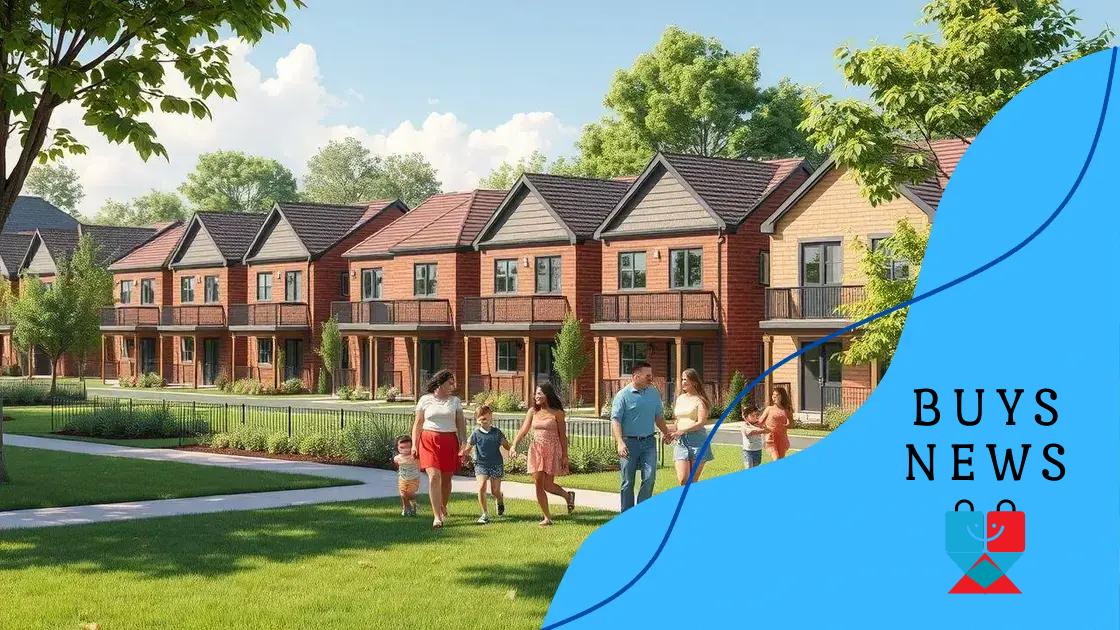Affordable housing initiatives that can change lives

Affordable housing initiatives provide essential support for low-income families by offering safe and stable living options, boosting community well-being, enhancing economic growth, and addressing critical housing shortages.
Affordable housing initiatives play a crucial role in addressing the housing crisis many communities face today. Have you ever wondered how these programs change lives and strengthen neighborhoods? This article explores their impacts, challenges, and successes.
Understanding affordable housing initiatives
Understanding affordable housing initiatives is vital for grasping how communities can tackle housing shortages. These programs aim to provide safe and stable housing to those who need it the most.
What are affordable housing initiatives?
These initiatives involve various programs and policies designed to help individuals and families access housing they can afford. Often backed by government funding, these initiatives can include:
- Subsidized housing
- Low-interest loans for homebuyers
- Rental assistance programs
- Community land trusts
By creating pathways to affordable living, they significantly impact local communities. Knowing the different types can help individuals find the right resources for their needs.
Why are they important?
Affordable housing initiatives are essential because they address critical issues of economic inequality. Families facing economic hardships often struggle to find stable housing, leading to homelessness and displacement. These initiatives help prevent such outcomes.
Furthermore, they contribute to healthier communities. Access to affordable housing improves education, job opportunities, and overall well-being. When residents can afford their homes, they are likely to invest more in their neighborhoods.
Wrapping this up, understanding how these initiatives function promotes awareness about housing rights and available resources. Knowledge empowers individuals to seek out affordable options and advocate for supportive policies that benefit all members of the community.
The impact of affordable housing on communities
The impact of affordable housing on communities is profound. It goes beyond just providing shelter; it helps strengthen social bonds and enhances community well-being.
Social Benefits of Affordable Housing
When families have access to affordable housing, they can focus on other important aspects of life. This stability can lead to:
- Improved educational outcomes for children
- Enhanced job opportunities for adults
- Greater community engagement and participation
- Lower rates of crime and homelessness
These benefits underscore how essential affordable housing is for fostering healthier, more connected communities.
Economic Impact
A stable housing situation also boosts the local economy. When residents can afford their homes, they are likely to spend more within the community. This leads to increased local business patronage and job creation.
Moreover, affordable housing can increase property values over time. As neighborhoods become more vibrant, new businesses often spring up, further enhancing the community’s economic landscape.
Investing in affordable housing is thus an investment in the future of the community. As families thrive, so does the neighborhood itself.
Access to affordable housing also reduces the burden on local services. When individuals are housed, they tend to use fewer emergency services and public assistance programs, allowing those resources to support others in need.
Successful case studies of affordable housing

Successful case studies of affordable housing provide valuable insights into how effective initiatives can transform communities. These examples show the tangible benefits that come from investing in stable housing.
Case Study: The 88th Street Project
One notable example is the 88th Street Project in Los Angeles. This initiative created 100 units of affordable housing for low-income families. Residents report a renewed sense of stability, leading to improved health and educational outcomes for their children.
- Increased community involvement
- Lower school dropout rates
- Higher family satisfaction and well-being
These outcomes highlight the positive ripple effects of providing affordable homes.
Case Study: The Atlanta BeltLine
The Atlanta BeltLine offers another successful model. This innovative project links public transit, parks, and affordable housing, revitalizing neighborhoods while providing more accessible living options. The initiative has resulted in:
- Public parks and green spaces
- Increased local business growth
- Job creation within the community
The BeltLine demonstrates that thoughtful urban design can foster economic growth alongside affordable housing.
Moreover, these case studies reflect how strong collaborations between local governments, nonprofits, and community members can lead to successful outcomes. Each project serves as a model for future initiatives, emphasizing the importance of community involvement and tailored solutions.
Challenges faced by affordable housing initiatives
Challenges faced by affordable housing initiatives are significant and often complex. Despite their importance, many programs encounter barriers that hinder their success.
Funding Issues
One of the main challenges is securing adequate funding. Many programs rely on government grants or private investments, which can fluctuate. This uncertainty can delay or even halt critical projects.
- Competition for limited resources
- Changing political priorities
- Lack of awareness about funding opportunities
Without consistent financial support, creating and maintaining affordable housing becomes increasingly difficult.
Regulatory Barriers
Regulatory challenges also play a significant role in hindering progress. Zoning laws and building codes can limit the development of affordable housing in certain areas. These regulations may restrict the types of housing that can be built or increase construction costs.
Moreover, community opposition, often referred to as NIMBYism (not in my backyard), can lead to significant hurdles for new housing projects. Residents may resist changes in their neighborhoods, fearing adverse effects on property values or community character.
All these regulatory and community factors can create lengthy approval processes, leading to project delays. Understanding these challenges is crucial in addressing them effectively, ensuring that affordable housing initiatives can thrive.
Future trends in affordable housing solutions
Future trends in affordable housing solutions are shaping the way communities address housing needs. As urban populations continue to grow, innovative approaches are emerging to provide affordable options for all.
Sustainable Development
Sustainability is a major focus in upcoming housing projects. Builders are increasingly using eco-friendly materials and energy-efficient designs. This not only lowers costs for residents but also benefits the environment.
- Green building practices
- Use of renewable energy sources
- Water-saving fixtures and appliances
These sustainable methods ensure that affordable housing can be both economically viable and environmentally friendly.
Technology Integration
Another exciting trend is the integration of technology in housing. Smart home features are becoming more common, making living spaces more efficient and enjoyable. For example, homes equipped with smart thermostats can help reduce utility bills.
Additionally, technology facilitates better management of affordable housing units, streamlining maintenance requests and improving communication between tenants and management.
The future of affordable housing will likely see increased collaboration between public and private sectors. Public-private partnerships can leverage resources and expertise to create more housing options. This collaboration can lead to creative financing solutions, making projects more feasible.
Lastly, community involvement remains crucial. Engaging residents in the planning process helps tailor developments to meet specific community needs, ensuring that the housing built is truly affordable and beneficial for those who live there.
In conclusion, affordable housing initiatives play a crucial role in enhancing community well-being. These programs not only offer shelter but also foster social ties and boost local economies. Successful case studies demonstrate the positive impact of these initiatives, despite the challenges faced, such as funding and regulatory barriers. Looking forward, trends like sustainable development and technology integration will further shape the future of affordable housing solutions. Engaging communities in these processes ensures that the housing created truly meets their needs and aspirations. By addressing these issues together, we can make strides toward equitable housing access for all.
FAQ – Affordable Housing Initiatives
What are affordable housing initiatives?
Affordable housing initiatives are programs designed to provide safe and stable housing for low-income individuals and families.
How do affordable housing initiatives benefit communities?
They enhance community well-being by improving social ties, boosting local economies, and providing stability for residents.
What challenges do affordable housing initiatives face?
Common challenges include funding issues, regulatory barriers, and community opposition, which can hinder project development.
What are some future trends in affordable housing?
Future trends include sustainable development practices, technology integration in homes, and increased community involvement in planning.





